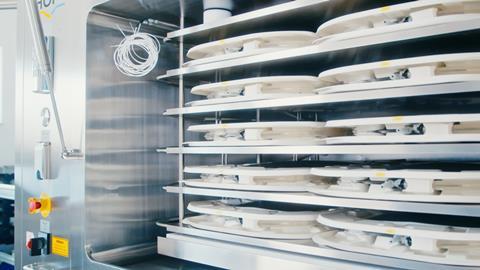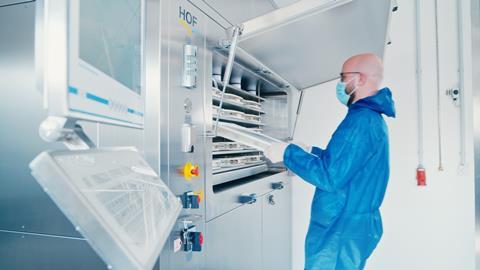In the pharmaceutical and biotechnological industry more and more products are processed within single-use bag systems. Besides the storage and transportation, the freezing and thawing processes are even more important and critical to the production process. The focus for freezing and thawing processes is on the one hand on fast and high performance rates and on the other hand on homogenous and controlled heat transfer into the product.
Compact machinery design and flexibility in production
The controlled rate freezing and thawing of products is done within the HOF Freeze-Thaw Units (FTUs). The machines are designed in a compact way in order to be integrated into existing production areas without major modifications at the Customer sites. The compact machinery design allows for the integration into CNC areas as well as for the integration into sterile areas without requiring too much production space. The overall design in stainless steel facilitates the cleaning of the machinery tremendously.
As there are many different kind of bag and shell combinations available on the market, the HOF FTUs are designed in a flexible way to allow for the handling of all common combinations on the market. This flexibility allows the Customer to process multiple products within the same machine. The overall design of the HOF FTUs allows for the handling of up to 300 liter of product per batch.
Sustainability is the key
Nowadays, besides the reliability and robustness of the machines, sustainability is the most dominating item while planning a process machine for ultra-low temperature application. Due to the F-gases regulation within the European Union and other climate protection directives the usage of synthetic refrigerants is either already limited or will be prohibited over the next couple of years. Besides this, synthetic refrigerants are reduced step-by-step in a phase-down scenario in order to keep the main goal of limiting global warming. As a result, synthetic refrigeration solutions are no longer future-proofed on the European market.
To face these limitations and regulatory requirements and still provide reliable machineries, HOF has developed alternative refrigeration solutions which are no longer only concepts on a paper, but existing solutions with already proven technologies. Therefore, three alternative refrigeration systems have been developed over the past years. These alternative solutions are either based on liquid nitrogen (LN2), the usage of natural refrigerants (HOF CAR6) or with an air-cooled refrigeration machine (HOF FTU Air-Line).
All systems are fulfilling regulatory requirements while keeping the necessary refrigeration capacities to ensure rapid freezing processes. The HOF FTU Air-Line provides the next generation of Freeze-Thaw Units with a completely natural solution while keeping the compact machinery design. As only air is used as a refrigerant no safety regulations apply to this kind of technology and with a GWP of 0, the system is completely natural. As the overall design of the Freeze-Thaw Units has not been changed, the HOF FTU Air-Line provides an alternative technology while keeping the same freezing and thawing conditions as for existing equipment. Therefore the FTU Air-Line can easily be integrated into existing processes or be used as replacement for existing machineries. So the Air-Line execution is the sustainable successor of the so far reliable FTUs on the market.
From the basic concept over the manufacturing to the qualification and after sales
With more than thirty years of experience HOF Sonderanlagenbau is the leading expert in manufacturing of plate Freeze-Thaw Units for single use processes within the pharmaceutical and biotechnological industry. With its own engineering and development departments, HOF support its Customers from the very basic idea and early steps towards the fabrication of the machines until the qualification of each machine at the Customer site. Further with each machine an intensive after sales support is included. The combination of a 24/7 service availability and an own warehouse with more than 65,000 components makes sure that potential downtimes are kept to a minimum and the runtime of the machines is increased to a maximum.
















